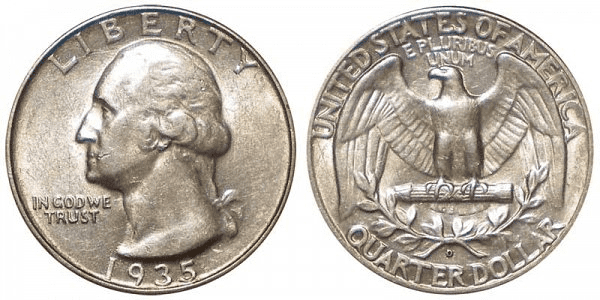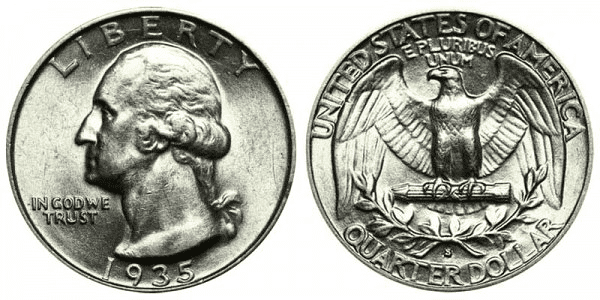What Is A 1935 Washington Quarter Made Of?
Congress approved a joint resolution in 1924, which was then signed by President Calvin Coolidge, to commemorate the 200th birthday of General and President George Washington.
The nation would have appropriate celebrations in 1932, the departed president’s bicentennial year, according to the decree.
The Great Depression compelled the commission to abandon the idea of the Washington quarter becoming a commemorative half dollar. There was little official Mint opposition when Representative Randolph Perkins introduced a bill to change the Washington commemorative denomination because the Standing Liberty quarter was challenging to strike and the dies wore out too quickly, requiring a higher level of effort by mint officials.
But this choice was made after the Bicentennial Commission had already launched a design contest and chosen a submission from the renowned coin artist Laura Gardin Fraser.
However, Secretary of the Treasury Andrew Mellon chose to organize a second design competition rather than modifying Fraser’s medallic submission for the half-dollar commemoration.
This second competition in 1931 is when the design by American sculptor John Flanagan got its start. In a contentious decision, Secretary Mellon chose Flanagan’s design over Fraser’s after the Commission rejected it a second time. This choice led to a small scandal at the time, and it is a fascinating piece of numismatic history.
The Washington quarter was first produced in 1932, when 6,248,800 coins were struck, significantly exceeding the amount that was needed due to the Great Depression.
As a result, 1933 saw the absence of coinage. The United States Mint mandated an increase in production over the prior year in 1935, the third year of issuance.
In contrast to the previous year’s total of 35,439,252 coins, the Philadelphia Mint produced 35,484,000 coins, the San Francisco Mint 5,660,000 coins, and the Denver Mint 5,780,000 coins for a total of 46,924,000 coins.
The obverse of the 1935 Washington quarter, which was produced by John Flanagan, is based on a bust of the general made in 1785 by neoclassical French sculptor Jean-Antoine Houdon.
The motto IN GOD WE TRUST, with the 1935 version employing the transitional medium weight phrase, is located beneath the left-facing bust.
Along the top of the coin’s field is the phrase LIBERTY, and below that is the year 1935. At the base of the bust in 1935, Flanagan’s initials “JF” are inscribed in tiny letters above the “5”.
The potential sculptors were given free rein to create the Washington quarter reverse, unlike the obverse. The heraldic eagle with a left-facing head and spread wings dominate Flanagan’s reverse.
The mintmark is situated in the middle of the two stems of the interwoven olive branches beneath the eagle, which is seated on a tidy bundle of arrows.
The two primary inscriptions UNITED STATES OF AMERICA and E PLURIBUS UNUM are visible above the eagle.
Last but not least, the denomination is printed out as QUARTER DOLLAR at six o’clock on the design. The edges of all Washington quarters, including the 1935 issue, are reeded.
Like many coins from this era, the 1935 Washington Quarter is comprised of 90% Silver and 10% copper. The silver content of this coin weighs 0.18084 troy ounces (5.62 g).
What Could You Buy For A Quarter In 1935?
With unemployment standing at 20.1% in 1935, the United States was still suffering from the Great Depression.
War also loomed as Germany began to rearm and implemented the Nuremberg Laws, which denied Jews civil rights. The Boulder (Hoover) Dam was also built in this year.
The China Clipper is the first aircraft to carry airmail across the region, and Amelia Earhart was the first woman to fly alone across the Pacific Ocean.
Additionally, a Mickey Mouse short film in technicolor makes its premiere in the entertainment industry.
In 1930s America you could get far more for your quarter than today. For example, a Dozen Eggs would set you back around 18 cents, a Jumbo Sliced Loaf of Bread cost 5 cents, 18 cents would get you 10 pounds of potatoes and Toilet Tissue was 9 cents for 2 rolls.
In terms of purchasing power, $0.25 in 1935 is comparable to roughly $5.33 in modern times, a rise of $5.08 over 87 years. Between 1935 and the present, the dollar had average annual inflation of 3.58 per cent, resulting in a total price increase of 2,033.55 per cent.
In other words, prices now are 21.34 times more than they have been on average since 1935.
1935 Quarter Varieties
1935 Quarter With No Mint Mark
Year: 1935
Face Value: $0.25
Composition: 90% silver, 10% copper
Silver Weight: 18084 oz.
Total Weight: 6.25g
Diameter: 24.26 mm (0.955 in)
Thickness: 1.75 mm (0.069 in)
Edge: 119 Reeds
Minted in: Philadelphia
Quantity Minted: 32,484,000

1935 D Quarter
Year: 1935
Face Value: $0.25
Composition: 90% silver, 10% copper
Silver Weight: 18084 oz.
Total Weight: 6.25g
Diameter: 24.26 mm (0.955 in)
Thickness: 1.75 mm (0.069 in)
Edge: 119 Reeds
Minted in: Philadelphia
Quantity Minted: 5,780,000

1935 S Quarter
Year: 1935
Face Value: $0.25
Composition: 90% silver, 10% copper
Silver Weight: 18084 oz.
Total Weight: 6.25g
Diameter: 24.26 mm (0.955 in)
Thickness: 1.75 mm (0.069 in)
Edge: 119 Reeds
Minted in: San Francisco
Quantity Minted: 5,660,000

List of Errors
There are no widespread errors seen in the 1935 Quarters, and instead all errors such as cud errors, clipping, and so on, are on a coin-by-coin basis.
How Much Is A 1935 Quarter Worth Today?
The 1935 quarter currently has a melt value of $4.08 at the time this article was created, when the spot price of silver was $22.79 (USD) per ounce.
Even the lowest grades of the coin have a lower numismatic value than their bullion value. (The average price for AG quarters is $5, whereas VF items might cost up to $20–25 more).
Listed below are the average values for Washington Quarters, categorized by their respective mint marks and grades.
| Coin | G-4 | VG-8 | F-12 | VF-20 | EF-40 | AU-50 | MS-60 | MS-65 |
| 1935 (P) Quarter | $5.36 | $5.97 | $6.27 | $6.54 | $7.04 | $8.72 | $25 | $170 |
| 1935 (D) Quarter | $5.36 | $5.97 | $6.54 | $8.72 | $24 | $141 | $274 | $721 |
| 1935 (S) Quarter | $5.36 | $5.97 | $6.54 | $7.48 | $14 | $43 | $113 | $343 |
How Does The Grading System Work?
The Sheldon Scale is used by numismatists to provide a numerical value to coins. The Sheldon Scale goes from poor (P-1) to perfect mint state (P-1) (MS-70). Coins were originally evaluated using words to reflect their condition (Good, Fair, Excellent, Etc.). Unfortunately, coin collectors and dealers had different ideas about what each of these terms represent.
Professional numismatists joined together in the 1970s and established CoinGrading standards. These numismatists now assign grades at key places on the seventy-point scale, using the most regularly utilized numeric points in conjunction with the original adjective grade. The following are the most common coin grades:
-
-
- (P-1) Poor – Indistinguishable and probably damaged; if used, must have a date and mintmark; otherwise, rather battered.
- (FR-2) Fair – Nearly smooth, but without the damage that a coin graded Poor often possesses. The coin must have enough detail to be identified.
- (G-4) Fair – Inscriptions have merged into the rims in some areas, and important elements have been mostly erased.
- (VG-8) Very Good- A little weathered, but all of the primary design elements are visible, albeit faintly. There is little if any, central detail left.
- (F-12) Good – The item is very worn, yet the wear is even, and the overall design details stand out clearly. Rims are almost completely isolated from the field.
- (VF-20) Very Fine – Moderately weathered, with some finer features still visible. The motto or all letters of LIBERTY are readable. Both sides of the coin have entire rims that are separated from the field.
- (EF-40) Extremely Fine – Gently used; all gadgets are visible, and the most important ones are bold. The finer details are bold and clear, however, light wear may be seen.
- (AU-50) Uncirculated – Slight evidence of wear on the coin’s design’s high points; may have contact marks; eye appeal should be adequate.
- (AU-58) Uncirculated Choice – Slight traces of wear, no severe contact marks, almost full mint shine, and great eye appeal.
- (MS-60) Mint State Basal – Strictly uncirculated; no indication of wear on the coin’s highest points, but an unsightly coin with reduced luster, visible contact marks, hairlines, and other flaws.
- (MS-63) Mint State Acceptable – Uncirculated, but with contact scratches and nicks, little reduced shine, but otherwise appealing appearance. The strike is weak to average.
- (MS-65) Mint State Choice – Uncirculated with great mint shine, very little contact blemishes, and exceptional eye appeal. The strike is unusually severe.
- (MS-68) Mint State Premium Quality – Uncirculated with superb luster, no obvious contact marks to the naked eye, and exceptional eye appeal. The strike is quick and appealing.
- (MS-69) Almost Perfect Mint State – Uncirculated with perfect brilliance, a sharp and appealing strike, and extremely good eye appeal. A near-perfect coin with minor imperfections in the planchet, strike, and contact markings (seen only under 8x magnification).
- (MS-70) Mint State Perfect – Under 8x magnification, there are no tiny imperfections discernible; the strike is crisp, and the coin is perfectly centered on a beautiful planchet. Rarely seen on a coin, this coin is bright and whole, with original luster and exceptional eye appeal.
-
Where To Buy Or Sell 1935 Quarters?
As with almost all other silver coins, you’re unlikely to happen upon this type of currency in your pocket change because most savvy collectors have already snapped them up for their precious metal value. Therefore, buying and selling 1935 quarters is mostly an affair for specialist dealers and online marketplaces.
Remember, the 1935 Quarter has more numismatic value than its melt value, so while a silver merchant would be more than happy to take them off your hands, you won’t be getting the most bang for your buck or quarter in this case.
As you can see by the price chart above, 1935 Quarters up to EF40 can be purchased for under $50, meaning you’re pretty safe taking a chance on an eBay listing.
Coins graded AU-50 and above are better off being bought and sold at specialist auctions. This means that the seller gets the best possible price, and the buyer has complete peace of mind that the coin they are purchasing is genuine.
FAQs
Where is the mint mark on a 1935 quarter?
The mintmark on 1935 Quarters is situated in the middle of the two stems of the interwoven olive branches beneath the eagle, which is seated on a tidy bundle of arrows. Remember coins minted in Philadelphia do not have a mint mark.
What does it mean if a quarter has no mint mark?
Coins without a mint mark were struck at the Philadelphia mint.
Is a 1935 quarter rare?
While in the grand scheme of things, 1935 Quarters aren’t super rare, they’re still a nice find and certainly a fine piece in any collection.
Are quarters from the 1930s worth anything?
Yes, because they contain 90% silver, 1930s quarters have a decent melt value let alone any added numismatic value.
